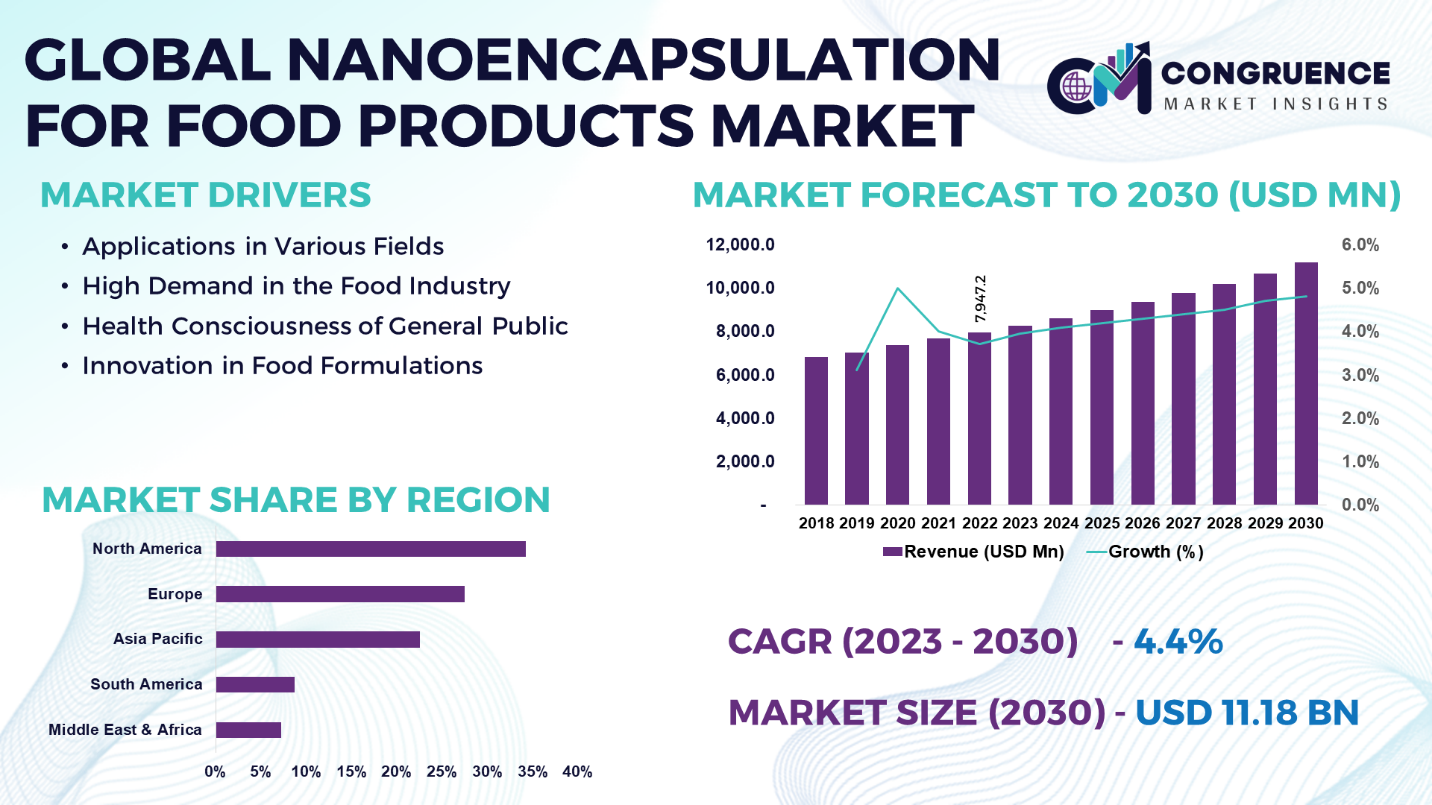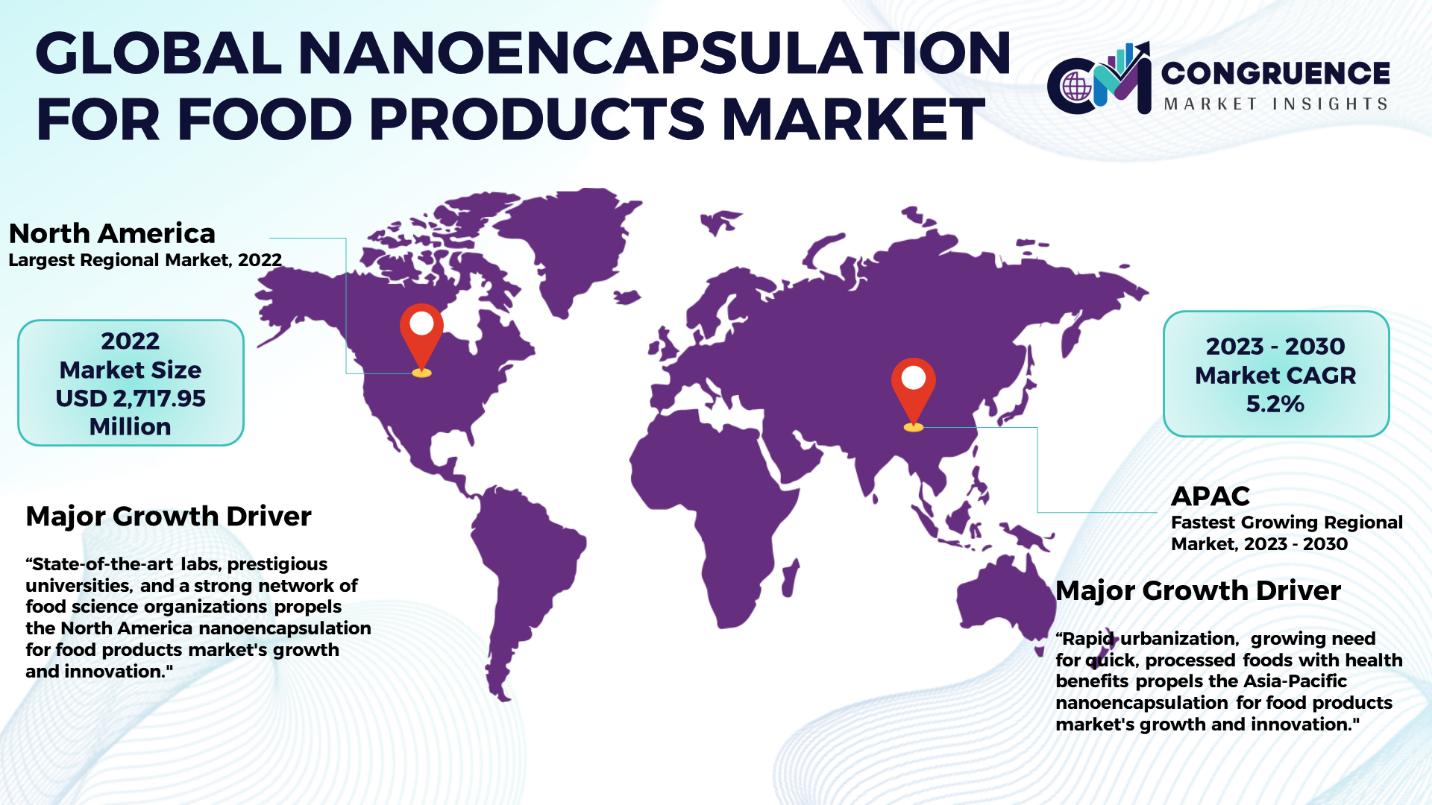Reports
The Global Nanoencapsulation for Food Products Market was valued at USD 7,947.2 Million in 2022 and is anticipated to reach a value of USD 11,182.9 Million by 2030 expanding at a CAGR of 4.4% between 2023 and 2030.
Nanoencapsulation is the process of encasing gas, liquid, or solid nanoparticles in a secondary material. The nanoparticles are referred to as the active material or core, and the secondary component as the shell or matrix. Vitamins, biocides, drugs, and scents are a few of the active ingredients in the core, which is contained within the shell and kept separate until it is needed. Nanoencapsulation is used in the food industry to deliver essential bioactive substances to targeted body areas. Many methods, including nanoemulsification, nanoestructuration, and nanocomposites, are used to include, absorb, and disseminate bioactive molecules such proteins, lipids, carbohydrates, and antioxidants within nano-sized vesicles. The food business incorporates difficult-to-get nutrients into functional and fortified food products using nanoencapsulation technology, enabling the body to absorb these nutrients. Furthermore, the most common sectors to use nanocapsulation in the form of liposomes and nanomicellees (a protein-based carrier system) are food supplements and functional beverages.

To learn more about this report, request a free sample
copy
Nanoencapsulation for Food Products Market Major Driving Forces
Applications in Various Fields: A growing number of industries, including pharmacological therapy, biomedical diagnostics, cosmetics, and food, are utilizing encapsulation technology. Micro-encapsulation and nanoencapsulation techniques are being developed and employed more and more in a wide range of sectors because of their exceptional features and benefits. Since that almost half of all pharmaceuticals manufactured have problems with low bioavailability, these advantages usually involve molecules in drug delivery systems having improved bioavailability.
High Demand in the Food Industry: Although nanoencapsulation is a relatively new technology, it has gained a lot of recognition and is currently one of the most used in the industry. Over the past few years, nanoencapsulation has been applied to a variety of food-related activities, such as food processing, production, packaging, transportation, and storage.
Health Consciousness of General Public: Growing educated population in the world is leading to heightened awareness regarding their food intake. Nanoencapsulation in food leads to better absorption of vitamins and minerals which is a prominent factor in driving its market.
Innovation in Food Formulations: The process of nanoencapsulation facilitates the creation of novel food items and formulations with improved sensory qualities, functionalities, and nutritional profiles in response to changing customer demands for convenient, luxuriant, and healthful food options.
Nanoencapsulation for Food Products Market Key Opportunities
Expansion in Emerging Markets: In order to increase their clientele, producers of nanoencapsulations can reach out to developing markets. Rising disposable incomes, urbanization, and shifting dietary habits are the main factors driving the industry in these areas. Growing health consciousness brought on by rising disposable incomes is propelling the worldwide nanoencapsulation industry.
Integration of Nanotechnology: Nanotechnology is rapidly being used in encapsulation methods. By precisely controlling the release processes of active chemicals, this approach improves the bioavailability and potency of tastes and nutrients. The development of nano-encapsulated components, which offer more effective delivery methods and innovative food products, is made possible by nanotechnology.
Customization and Personalization: Customers are looking for individualized diet plans more and more. Manufacturers of food products using nanoencapsulation can provide customization choices so that consumers can select dietary needs and health objectives that suit their preferences. This trend opens up new markets for premium and niche products by increasing customer involvement and brand loyalty.
Nanoencapsulation for Food Products Market Key Trends
· Growing consumer demand for functional foods with improved bioavailability that are nanoencapsulated.
· Increasing attention being paid to distinctiveness and premiumization using nanoencapsulation technology.
· The development of customized nutrition plans using nanoencapsulation methods.
· Expansion of nutraceuticals and nutritional supplements encased in nanoparticles.
· Implementing targeted delivery methods to release active substances gradually.
· Digital technology and nanoencapsulation combined for transparency and traceability.
· Cooperation to create novel nanoencapsulated products between the food and healthcare sectors.
· Increasing expenditures on the study and creation of cutting-edge nanoencapsulation methods.
· Support from regulations and guidelines that promote the commercialization of food products encased in nanoparticles.
· Expansion into developing markets as a result of urbanization and shifting nutritional habits.
Region-wise Market Insights
North America accounted for the largest market share at 34.2% in 2022 whereas, Asia Pacific is expected to register the fastest growth, expanding at a CAGR of 5.2% between 2023 and 2030.

To learn more about this report, request a free sample
copy
Over the course of the forecast period, North America dominates the food encapsulation market with market share of 34.2% in the global market. There is a robust infrastructure for food technology research and development in North America, especially in the United States. This includes state-of-the-art labs, prestigious universities, and a strong network of food science organizations. An environment such as this, fosters creativity and advancements in encapsulating technologies, which in turn propels industry expansion. According to estimates, the food encapsulation market would expand at the fastest rate in Asia-Pacific with CAGR of 5.2%. This region is experiencing rapid urbanization, which is changing consumer lives and dietary habits. The increasing demand for rapid, processed foods with health advantages from urban consumers is driving the need for encapsulated food items that can provide improved nutrition, flavor, and shelf life. Europe has the tightest food safety and quality rules in the world. These regulations support the use of encapsulation technology to improve the stability, shelf life, and safety of food products. Encapsulation maintains the integrity of beneficial components while guaranteeing controlled release in accordance with European food safety and quality requirements.
Market Competition Landscape
The market for food product nanoencapsulation is characterized by a dynamic and quickly shifting competitive environment. Market share and dominance are contested by a wide range of companies, from long-standing industry titans to innovative newcomers. As businesses compete fiercely to set themselves apart through greater product quality, price strategies, and customer pleasure, they are encouraged to continuously pursue innovation and extraordinary performance. Variables such as legislative changes, advancements in technology, and changing customer tastes influence market dynamics. This dynamic competition encourages strategic alliances, mergers, and acquisitions as companies fight to keep a competitive advantage in this ever-changing landscape. It also stimulates market expansion by posing opportunities and challenges to participants. The market for food products that use nanoencapsulation often offers an exciting range of competition, where success depends heavily on one's capacity to adapt and generate new ideas. Prominent players in the market include:
· Aquanova AG
· Blue California
· Capsulution NanoScience AG
· Frutarom Industries Ltd.
· GAT Food Essentials GmbH
· Lycored Corp.
· MicroEncapsulateTech LLC
· Nanocarrier Co., Ltd.
· NanoSphere Health Sciences Inc.
· Sante International, Inc.
· SmartMicroCaps
· TasteTech Ltd.
· Tagra Biotechnologies Ltd.
· Vitasquare GmbH
· BioDelivery Sciences International, Inc.
|
Report Attribute/Metric |
Details |
|
Market Revenue in 2022 |
USD 7,947.2 Million |
|
Market Revenue in 2030 |
USD 11,182.9 Million |
|
CAGR (2023 – 2030) |
4.4% |
|
Base Year |
2022 |
|
Forecast Period |
2023 – 2030 |
|
Historical Data |
2018 to 2022 |
|
Forecast Unit |
Value (US$ Mn) |
|
Key Report Deliverable |
Revenue Forecast, Growth Trends, Market Dynamics, Segmental Overview, Regional and Country-wise Analysis, Competition Landscape |
|
Segments Covered |
· By Technology (Liposomes, Nanoparticles, Emulsions, Micelles, Coacervation, Sol-Gel Encapsulation) · By Encapsulation Material (Polysaccharides, Proteins, Lipids, Cyclodextrins, Others) · By End-user (Adults, Children, Elderly) · By Application (Functional Foods, Dietary Supplements, Nutraceuticals, Beverages,Bakery Products, Dairy Products, Confectionery, Others) |
|
Geographies Covered |
North America: U.S., Canada and Mexico Europe: Germany, France, U.K., Italy, Spain, and Rest of Europe Asia Pacific: China, India, Japan, South Korea, Southeast Asia, and Rest of Asia Pacific South America: Brazil, Argentina, and Rest of Latin America Middle East & Africa: GCC Countries, South Africa, and Rest of Middle East & Africa |
|
Key Players Analyzed |
Aquanova AG, Blue California, Capsulution NanoScience AG, Frutarom Industries Ltd., GAT Food Essentials GmbH, Lycored Corp., MicroEncapsulateTech LLC, Nanocarrier Co., Ltd., NanoSphere Health Sciences Inc., Sante International, Inc., SmartMicroCaps, TasteTech Ltd., Tagra Biotechnologies Ltd., Vitasquare GmbH, BioDelivery Sciences International, Inc. |
|
Customization & Pricing |
Available on Request (10% Customization is Free) |
